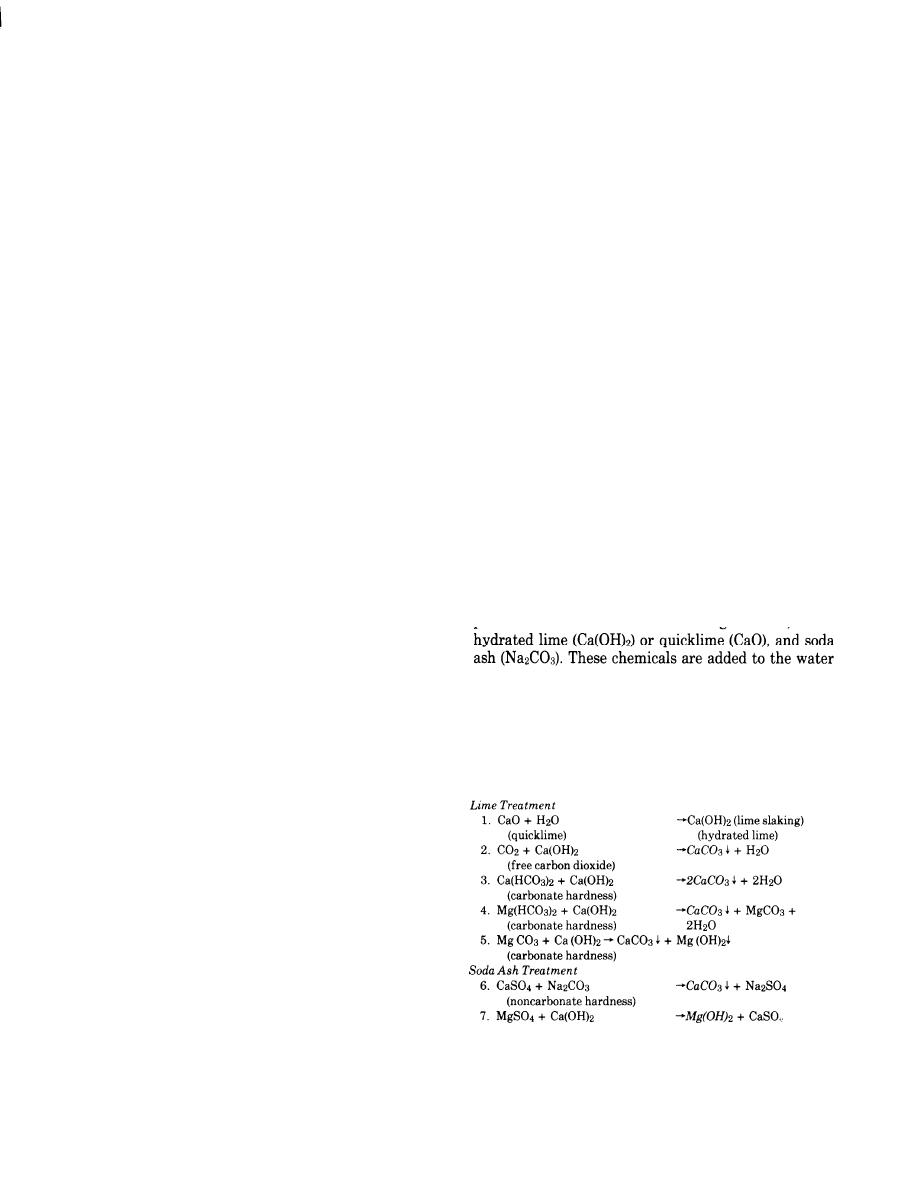
TM 5-813-3/AFM 88-10, Vol 3
icantly reducing odor associated with dissolved
exchange water softeners to reduce the hardness to
organics.
zero is recommended.
c. Absorption. Powdered activated carbon is com-
(4) Boiler water. Boiler water for power plants
monly used for removal of tastes, odor and color by ad-
and heating plants may require softening, but satisfac-
sorption. The carbon can be applied to the water at any
tory results can often be obtained by application of
point in the treatment plant prior to filtration, but it is
corrosion and scale inhibitors. Depending on the pres-
usually advisable to apply it early in the treatment
sure at which the boiler is to operate, partial water-de-
process to prolong contact. For maximum effective-
mineralization may also be necessary, See paragraph
ness, carbon should be applied well ahead of chlorine,
2-13a. for additional information on demineralization.
and preferably in advance of lime softening, The in-
(5) Dining facilities. The installation of softeners
fluent to a presedimentation basin is normally an ef-
for small dining facilities, latrines and bathhouses is
fective carbon application point. Powdered carbon dos-
not recommended. However, water softeners to reduce
ages usually range from 5 to 10 mg/L, but as much as
hardness to 50 mg/L maybe justified for large central
50 mg/L may be required. The use of powdered acti-
dining facilities to protect equipment and to insure
vated carbon adds more suspended solids and increases
satisfactory washing of dishes. Each such instance will
the amount of sludge, thereby creating a sludge dis-
be justified separately.
posal problem. Powder activated carbon is marginally
(6) Hospitals. When the water supplied to a hospi-
effective in reducing TTHMs. Granular activated
tal has a hardness of 170 mg/L or more, the water will
carbon (GAG) has also been used for taste and odor re-
be softened to approximately 50 mg/L. Where critical
moval. It has been employed as a separate treatment
equipment requires water having a hardness of less
step in the form of carbon columns and as a substitute
than 50 mg/L, as special study will be made to deter-
for sand in the filtration process. Used in this way, the
mine the most feasible means of obtaining water of the
granular carbon serves in a dual capacity as a filtration
necessary hardness. Zero hardness water may be piped
medium and for taste and odor removal. Granular acti-
from the main softener or maybe supplied from small
vated carbon is also excellent at reducing TTHMs.
individual softeners, whichever is the more feasible.
Granular activated carbon must be reactivated on a
The sodium content of the treated water must be taken
regular basis to keep its absorptive abilities. Because
into account when selecting a softening method for
of the cost of reactivation of GAC, other methods of
hospitals.
taste-and-odor control and reduction of TTHMs should
b. Lime-soda ash process,
be considered. Aeration is generally more cost-
(1) Softening chemicals and reactions. The princi-
effective than GAC contractors.
pal chemicals used to effect softening are lime, either
2-10.
Softening.
to be softened and react with the calcium carbonate
Whether water softening is provided will depend en-
and magnesium in the ater to form insoluble com-
tirely on the type of project and the uses to be made of
pounds of calcium carbonate and magnesium hydrox- .
the water. Two general types of processes are used for
ide. If quicklime is used, it is usually converted to a
softening: The "lime-soda ash" process and the "cation
slurry of hydrated lime by slaking with water prior to
ion exchange" or "zeolite" process.
application. The chemistry of the process can be illus-
a. Applications.
trated by the following equations:
(1) Permanent posts or bases. Softening of the en-
tire supply for a permanent post or base may be con-
sidered if the hardness exceeds 200 mg/l, with hard-
ness expressed as equivalent CaCO3. Softening of a
post water supply to a total hardness of less than 100
mg/L is not required, however, softening to less than
this amount is justified for the special purposes and
services given in paragraphs (3), (4), (5), and(6) below.
(2) Nonpermanent bases. For Army temporary
construction and for Air Force bases not in the perma-
nent category, the entire supply will not be softened
unless the total hardness exceeds 300 mg/L. However,
when a treatment plant is constructed for the removal
of turbidity or iron, the plant may also be designed to
All of the above reactions can be accomplished in a
accomplish partial softening.
single stage of treatment. Lime and soda ash can be
(3) Laundries. Water for laundries shall have a
added at the same point and will react with each other;
hardness of 50 mg/l or less. Installation of cation ion
2-19


 Previous Page
Previous Page
